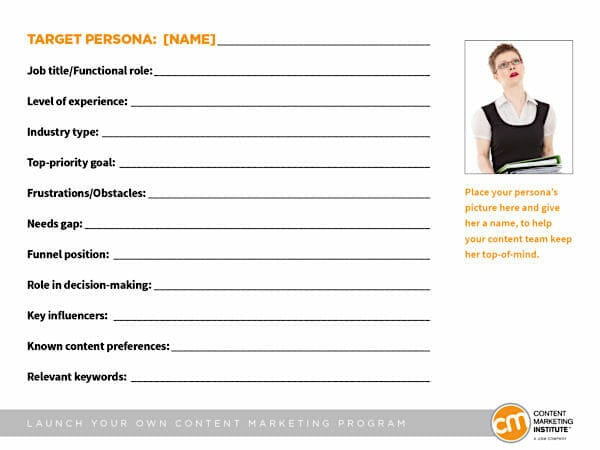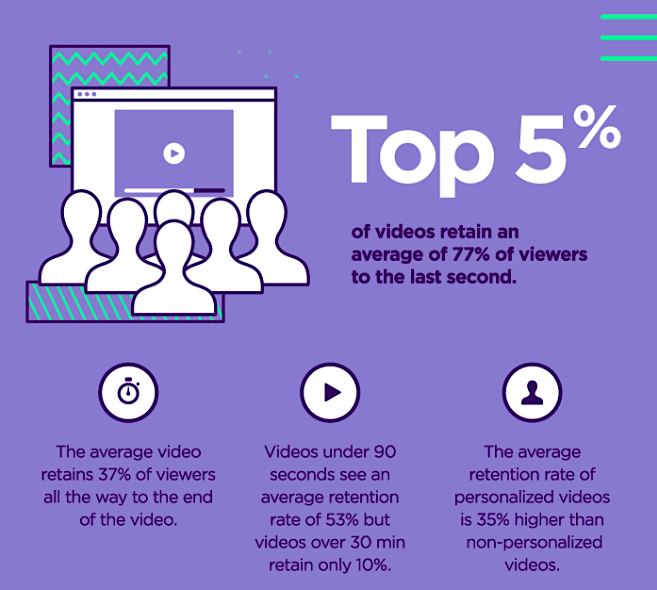Developing relevant, timely and evergreen content is a huge task. Higher education is an already competitive market, and online education is hard to advertise without a visible campus. Less visibility makes it difficult for prospects and students to feel part of a wider cohort and harder still for institutions to foster a sense of community.
A particular difficulty for online education providers is that they can often have multiple personas seeking the same or similar services.
Without the ease of matching the bulk of high school grads with an undergraduate degree, online education providers need to think about who is coming to them and the prospects’ circumstances that led them to an online option.
This is where you’ll need to start thinking about personalization in your student acquisition, as well as customer journey mapping.

Persona-Based Content Strategies
The Australian online education industry tops $5B in revenue annually and is expected to grow by 0.4% annually over the next 5 years. With room to grow into international markets, and content marketing costing 62% less than outbound marketing, now is the time to refine your persona-based content strategies.
In this article, we’ve simplified our personas into three examples: Career Starters, Career Enhancers, and Career Changers:
- Career Starters – include those who are in their final year of high school, as well as non-school leavers who may have left education a few years ago. These people only have entry level experience, likely in retail, fast food, or hospitality.
- Career Changers – include people who have spent several years in a single job or career, and want to try something new. They may have spent a few years out of the workforce as a stay at home parent, and now want to return to work now their children are older and at school.
- Career Enhancers – have substantial experience in the workforce, and may or may not have an undergraduate degree. Often, they’ll be seeking a promotion and will need to tick off some additional requirements through further education.
If you don’t have your personas written down in an actionable document, here’s a quick guide to get you started:

Learn More:
- How to Create a Marketing Funnel that Generates Sales (Templates Included)
- How to Set Up Marketing Funnels (TOFU, MOFU & BOFU)
- Attract the Right Prospects With Buyer Personas (Includes Step-by-Step Templates!)
Top of Funnel Content Marketing
Although business bottom lines look forward to the final conversion, content marketing is really about providing value to foster genuine relationships with your company or organization – whether or not a conversion is involved.
Having said that, content marketing can convert up to 6 times higher than other methods.
At the top of the funnel (ToFu), your content strategy might not even discuss the products or services you sell – it’s not the time to be pushing hard. This could be one of the first touch points a prospective student has with your institution. They might not know what you offer, your reputation or even what they want to study. This is where you can start building your relationships with prospects.
When we think about the questions that a prospect may have asked a search engine to at this stage, this is what they might look like:
- What is online learning?
- Is an online course right for me?
- Do I need a qualification to enter [example] industry?
- What do I need to study to be promoted to management?
- How long does it take to get a qualification?
- Are my industry skills transferable?
All these questions reflect the start of a customer journey, and you’ll need to respond accordingly. It’s likely that people asking these questions are feeling aspirational and a bit confused, with a healthy dose of skepticism thrown in as well.
This is your opportunity to assert your brand as an authority in the higher education sector, as well as an online education provider. If you develop great content that can answer your prospects’ questions, this will help you build trust and facilitate the start of long-term relationships – even if they don’t enroll this year.
Learn More: How to Use SEO for Higher Education to Rank Your School
Career Starters & ToFu Content
We’ve previously said that Career Starters are at the end of high school, or are only a couple of years into the workforce. It’s likely that their only professional experience has been in low-skilled positions, and they may not know anyone who has studied after high school.
These are the types of frameworks we’ll be keeping in mind as we develop our content.
Challenges and Pain Points
If they haven’t finished school yet, the prospect might be confused about the transition after graduation. They might not believe their high school results are good enough to consider further study, and they might want to know that they’ll be supported by a familiar teacher.
If they have been working for a couple of years, the unfamiliarity of institutional education may be off-putting, and they might be unsure how they’ll support themselves while studying. Online courses throw an additional barrier into the mix as a (perceived) non-physical institution.
Preferred Communication Style
At the moment, it’s likely that a prospect will be doing a lot of self-discovery online. They’re not quite sure what questions to ask just yet, and are looking for guidance of a general nature.
They’ll also be looking for people who appear similar to them who have had the same experience. This way, they can anticipate what’s around the corner and take a proactive approach. They want to take control of their future. These types of people can fall into several categories, including:
- Student ambassadors
- Alumni
- Family, friends and colleagues
How Do These Factors Shape Your Content?
With video now being the preferred way to consume content online, a great start would be to develop a profile series of student ambassadors. Video has higher engagement than other content formats – 64% of people buy something after watching a brand’s videos – and easily adds a human voice to your institution, which is essential for online spaces.
By reflecting a similar lifestage, the ambassador is in a unique position to communicate directly with prospects and tell their story. If an ambassador can empathize with circumstantial factors, such as being the first in family to undertake further study, or receiving low grades in high school, the power balance is equalized and a genuine conversation can start.
With this in mind, start addressing the example questions that your prospect is asking at this stage. Ideally, this would be across major digital platforms such as Facebook, Instagram and Snapchat, as they have very high youth engagement, as well as eDMs (Electronic Direct Mail).
This type of content does several things:
- It familiarizes the prospect with your brand
- It makes the prospect resonate with the people at your institution
- It makes the prospect take a step towards trusting your brand
Similarly, it is also ideal to showcase alumni success through video. Not only can this help the prospect identify themselves in a professional, post-graduation setting, it can also identify the skills they’ll learn and validate their aspirations.
Key Takeaway: Get to know the prospect and start the conversation on their terms.
Learn More:
- How to Optimize Your Content Strategy with the Buyer’s Journey
- How to Choose the Right Content for Each Stage of the Marketing Funnel
- Turning a Lead into a Prospect with MOFU Content
Middle of Funnel Content Marketing
By this stage, a prospective student should know who you are, the services you provide, and will have decided that they want to do an online course – and they’ll know that you can give them a solution.
The Middle of the Funnel (MoFu) content will need to reflect a narrowed change in direction to give prospects upfront information about their particular interests.
Here, their questions start turning to the course they might choose, how they will incorporate this into their life and the career outcome they can expect. Often, people will turn to online education because they are either too busy to attend campus-based courses, or they don’t live close to an education institution.
Let’s take a look at how a Career Changer might need help during this stage.
Career Changers & MoFu Content
We previously highlighted Career Changers as being in a single job for several years, or parents returning to work after caring for their children. They might be hesitant about how they will balance family life with study or not quite be sure how to study.
Career changers will also be keenly aware that they will be older than their counterparts for the level of qualification they are seeking.
Challenges and Pain Points
Cost is often a consideration when applying for any course. In addition to balancing study with work or family commitments, prospective students in this situation may feel that their financial circumstances will not allow them to dedicate time to study.
A major hurdle to overcome by prospective students might also be their confidence in their ability. Having been out of formal education for so long, these people will need to be supported both emotionally and practically. They will need to feel empowered to achieve their study goals.
Preferred Communication Style
At this stage, Career Changers will still be undergoing self-discovery online as well as talking to friends, family and industry professionals. Without a physical campus to explore or someone to speak with face-to-face, you’ll need to anticipate their questions and make your answers easy to find.
They’ll be looking for a familiar face with whom they have already engaged, such as a student ambassador, as well as advice to narrow down their course options.
For important information, a plain-language approach is essential so prospects can quickly make a decision in their best interest. Fees and scholarship information is essential to keep in mind here.
How Do These Factors Shape Your Content?
At this stage, it’s important to remember to be consistent with your approach. You can leverage the relationship you have built between your ambassadors and the prospect, for example, to highlight actual courses or other services.
If your online courses offer placements or apprenticeships, this is a fantastic opportunity to show your prospects what they can expect from their study with you. Extend the scope of your ambassador content to encompass this and not only will it strengthen the relationship with the ambassadors themselves, it will also validate your industry-based curriculum.
Consider longer vertical videos for Instagram TV, and shorter vertical videos for Instagram stories and Snapchat. Videos under 90 seconds have an average retention rate of 53%, which suits story formats:

These videos could feature parents who have returned to the workforce and facilitate conversations about study/family balance and returning to work after time way. This content is designed to empower the prospect – that they can study, that others like them have done so before, and that it will be good for their family as well.
When we consider that personalized videos have an average retention rate 35% higher than non-personalized videos, taking personas into account becomes critical.
Quizzes designed to help prospects narrow their interests or course options are another fantastic way to directly engage your audience.
Key Takeaway: Empower your prospect with information that speaks to them – don’t beat around the bush.
Learn More:
- How to Guide Your Customers Through the Marketing Funnel with Interactive Content
- A YouTube Video Marketing Guide to Increase Prospects in Your Funnel
- 5 Case Studies of Successful Marketing Funnels
Bottom of Funnel Content Marketing
You’re almost there! Your top and middle of the funnel content has been guiding prospects through their initial questions and has helped them decide on a specific area of interest and a course itself. They can see how your solution will help them, but need to be reassured and shown how they can apply or enroll.
Now it’s time for your Bottom of the Funnel (BoFu) content to give a prospect the support they need to make their final decision. In this stage, their questions will be about their final barriers. They should already be aware of course costs and course details such as length and the curriculum.
As an online course, a prospect will expect to be able to enroll and start studying quickly. Prospects do not approach online education in the same way as a traditional provider; there is no campus where fun student experiences can be found, so outline application dates and enrollment dates clearly.
A prospect may also be asking questions as to whether your course is something they really need, or if it’s just a nice-to-have option. Can they afford not to do this if they want to achieve more in their career?
Career Enhancers & BoFu Content
As we outlined earlier, a Career Enhancer already has substantial experience, possibly with the added benefit of an undergraduate degree. They’ll likely want better pay, more responsibility and a challenge in the next step of their career, and they need your course to help make it happen.
Once in a senior position, competition for fewer roles is increasingly fierce, which incentivizes prospects to gain an edge over their peers. In this case, we can see why the student experience is less important for a career enhancer: they are extremely outcome driven.
Often, Career Enhancers will be seeking a promotion and will need to tick off some additional requirements through further education.
Challenges and Pain Points
Time is the big factor to be considering at this stage for Career Enhancers. Busy with family and work, further study must come third in this hierarchy. Studying on campus is already too onerous, but they don’t want to run the risk of receiving a worthless online course.
At the same time, prospects like this need to know they’ll be supported with flexibility and access to course materials when they need them. They can’t accommodate rigid study hours easily.
Preferred Communication Style
A highly outcome-driven persona combined with a bottom of the funnel stage means that your prospect wants to be communicated with directly and clearly.
Active on LinkedIn and familiar with industry expectations, they need to be convinced that your course is of industry standard and there is a clear path to start if they want to do so immediately. Although they may be grouped with student ambassadors through previous content, they will likely want to see alumni outcomes to reassure them that the course they are choosing is the right choice.
By this stage, you ought to have an idea of your prospects’ course preferences through proactively profiling site visitors and Facebook users. As we are now at the bottom of the funnel, a highly personalized experience is essential.
How Do These Factors Shape Your Content?
Ideally, this stage will correlate with a well-formed profile of each prospect. They should only be receiving information that’s relevant to their preferred course or course area, as well as direction to financial support and steps to enrollment if they have been visiting these pages regularly.
Trigger emails that serve helpful content corresponding to those pages are an excellent way to prompt audiences towards the final application step. Alternatively, place the prospect within a course-based nurture early in the funnel that serves key financial and application information at a week or so prior to the date of intake.
Due to their easily digestible format, videos are once again a priority. An application walk-through video makes the actual process fast and straightforward in ways a factsheet cannot. Host these on your website and link to them within a dedicated email.
Not only will this be great content for SEO, but video in emails lead to a 200-300% increase in click-through-rates.
Similarly, a video of how individual units are arranged and course progression occurs can turn an abstract idea into something more concrete.
To reaffirm the final value of your offering, an alumni interview or Q&A reflecting post-graduation success is essential to complement any industry accreditations your course might have. These prospects want to visualize their outcome and be reassured that their industry will acknowledge their expertise with your institution’s stamp of approval.
A video interview outlining any recognition for prior learning is another way to address concerns that a course might take too long.
Key Takeaway: Personalize your content and proactively answer the final need-to-knows. Start the conversations your prospect might not otherwise ask.
Learn More:
- How to Build a Social Media Marketing Conversion Funnel
- How to Build a Facebook Chatbot Marketing Funnel
- Why You Should Use Multiple Channels to Maximize Your Customer Acquisition
Where Else Can You Optimize Your Content Marketing?
Here, we’ve only just scratched the surface with content marketing. While you consider your personas and their relationship with the marketing funnel, it’s also important to consider factors such as marketing automation strategies, the role of data in content development, and how to ensure that your content is sitting natively within platforms you choose.
Most importantly, you need to be consistent. With 60% of marketers publishing at least one piece of content daily, there is a lot of competition – but big rewards when you get it right.
Until then, it’s time to start mapping out personas for your online education institution.




